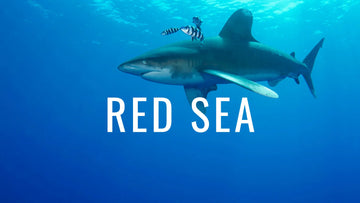One of the first big international diving trips we Europeans make is to the Red Sea. After a short trip to Malta, I arrived in Sharm El Sheikh with an extraordinary illusion: after dozens and dozens of local dives, I was finally going to dive in coral gardens! I was crazy to have sharks in front of me, to dive in the mythical Thistlegorm, my first experience of life on board, clownfish, humphead wrasse fish.... The Red Sea is a dream as a first dive destination. And after visiting and revisiting it, it never disappoints. So let's try to combine all the diving in the Red Sea, its best areas, fauna and tips for those who want to know this unique enclave in the world.
Few places in the world are as directly associated with diving as the Red Sea. This gulf of the Indian Ocean is 2,200 km long and reaches depths of over 2,000 meters, providing rich waters and nutrients that feed its beautiful coral gardens. Considered one of the 7 wonders of the underwater world and playing a crucial role in the development of maritime trade for centuries, you can visit the Red Sea on liveaboards that take you to the best of the northern route, such as Sharm el Sheik and the Hurghada shipwrecks, or to the south, exciting and less crowded, with extraordinary coral gardens and the sharks of Marsa Alam.
You can go even further south, to Sudan, where you can enter the spooky Umbria wreck or access the unique underwater city of Jacques Cousteau, one of the first divers to recognize the value of the underwater life of the Red Sea, to which he devoted much of his career.
T-shirts for ocean lovers
VIEW MORE T-SHIRTS FOR DIVERSThe other way to dive the Red Sea is from resorts and hotels, which also offer the opportunity to add to the dive trip the chance to visit one of the most attractive and long-lived civilizations in history. You'll have the opportunity to visit Cairo, with its boundless National Museum, or take a cruise on the Nile and reach the Valley of the Kings, enough incentives to help you decide to take a diving trip to the Red Sea... which you will never regret.
The Red Sea gets its name from the proliferation of algae that give its waters a reddish hue. It is home to over 1,000 species of invertebrates, 250 species of soft and hard corals, and over 1,100 species of fish that live in clear waters with visibility up to 40 meters.
The Red Sea offers thousands of dive sites, whether you are a beginner or an experienced diver who loves the thrill: vertical walls, dozens of wrecks, coral gardens, the Blue Hole in Dahab, diving with large pelagic creatures such as whale sharks, hammerhead sharks or the fearsome oceanic whitetip shark, and even sites for those who just want to snorkel.
Book your dive on the Red Sea
VIEW ALL RED SEA DIVING DEALSThe Red Sea is usually one of the first destinations for divers "leaving home" for their first dive trip, mainly because of the quality of the diving and the variety of options and prices offered. It is also perfectly located between Europe and Asia.
You can dive in the Red Sea at any time of the year, although water temperatures can vary greatly. From June to August the water can reach 30°C, but drops to 20°C in February. Air temperatures in Egypt can reach over 40°C in the summer, but drop to a pleasant 20°C in the winter. The whale shark season, one of the attractions of the Red Sea, runs from the end of May to the end of July. This is the time when this majestic animal can be seen mainly in the north of the Red Sea, but also in some spots in the south.

Even snorkelers can enjoy the diving with whale sharks. Picture by Eric Burgers
NORTH RED SEA DIVE SITES
The possibilities for diving in the Northern Red Sea Route are endless and the combinations almost limitless. You can join wreck safaris or wreck dive sites plus coral reefs. You can find "adrenaline" dives with strong currents and vertiginous walls, but you can also learn to dive in a privileged area or simply snorkel in places where corals are inches from the surface.
Best diving areas in north Red Sea routes
Sharm el Sheikh
Sharm El Sheikh is recognized as one of the top diving destinations in the world. It combines a collection of the best you can find in the Red Sea: color, abundance of coral, wreck diving and a great variety of fauna. Sharm el Sheikh has attractions for all divers, from wrecks of great beauty and fascinating history such as the Thistlegorm, to extraordinary coral reefs in Ras Mohammed National Park with more than 1,200 species of fish and 220 species of coral, to adrenaline filled dives in the Straits of Tiran with its strong currents and drop-offs, and unexpected glimpses of beautiful predators such as whale sharks or hammerhead sharks. Sharm el Sheikh is an essential stop on any northern Red Sea diving itinerary. Read more about diving in Sharm el Sheikh. Keep reading about diving in Sharm el Sheikh >>>
Hurghada
Hurghada is famous for its shipwrecks, with over 10 spectacular shipwrecks where the quality of marine life is exceptional, but there are others, such as the Salem Express, that represent a great drama and diving it is overwhelming. One of the most interesting places in Hurghada is the Abu Nuhas reef, a real magnet for ships, where you can find wrecks that sank a century apart, but are separated by only a few meters.

But wrecks are not the only attraction in Hurghada. Healthy coral reefs are also teeming with colorful marine life. You can dive with bottlenose dolphins, turtles, schools of carangidae, tuna, barracuda and even oceanic white tip sharks. Keep reading about diving in Hurghada >>>
Best diving areas in southern Red Sea routes
The southern Red Sea diving route is much less known than the northern route and requires more experience and more dives in your logbook. The southern Red Sea is known for its healthy corals, much better treated than the northern ones, and the chance to dive with large pelagic animals, mainly sharks, in a less crowded area where strong emotions are guaranteed.
Marsa Alam
Marsa Alam is the area that holds some of the best and most famous diving spots of the southern Red Sea. Those who have already traveled south know that Daedalus, Elphinstone or Brother Island are synonymous of diving with sharks, like the oceanic whitetip shark, the gray shark and even hammerhead or tiger sharks. Some of the best pictures of the oceanic whitetip sharks you’ve seen have been taken in this area. The reefs of Marsa Alam are plenty with healthy coral, a great environment for a huge variety of reef fish such as the giant parrotfish and a strange creature, the dugong, a sort of peaceful “sea cow”. Keep reading about diving in Marsa Alam >>>
St. John's
St. John’s is the border between the Egyptian and the Sudanese Red Sea. The six islands that make up this area belong to the Elba National Park and provide a luxury diving holiday away from the crowds. Divers who visit St. John’s are looking for strong emotions including walls that descend to 200 meters deep and strong currents that bring large predators like hammerhead sharks, turtles, dolphins, manta rays and barracudas that come to feed of the enormous variety of large and small reef fish that live here. Keep reading about diving in St. John's >>>
Sudan
Sudan is outside of the classic diving routes of the Red Sea because it has not built as a strong diving industry as Egypt so the access to its reefs is more complicated. Even though their underwater treasures are so extraordinary, as good or even better than the Egyptians and much less crowded. The divers who choose to Sudan as a diving destination will find pristine reefs that keep underwater science fiction stories as the laboratory of Jacques Cousteau Conshelf II, a world class wreck like the Umbria, schools of hammerheads only comparable to Cocos Island, whale sharks, manta rays and an extraordinary variety of reef fish. Sudan is still a virgin territory for challenging divers. Keep reading about diving in Sudan >>>


























